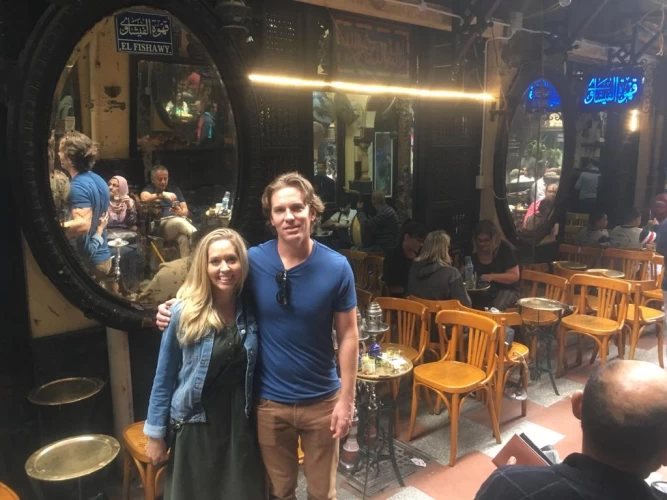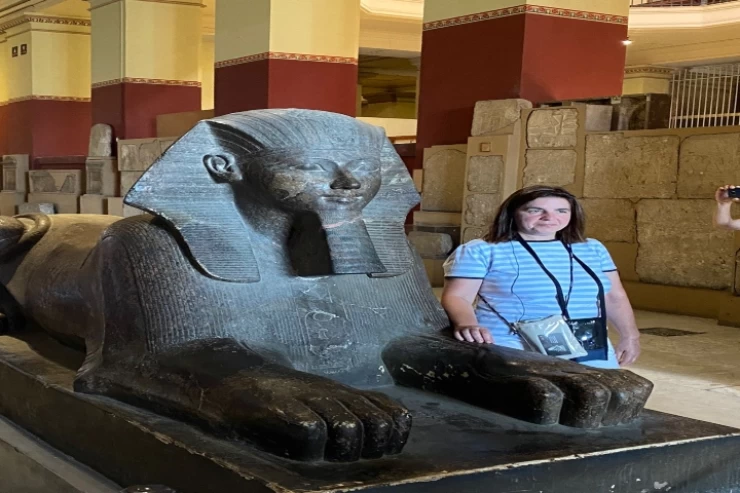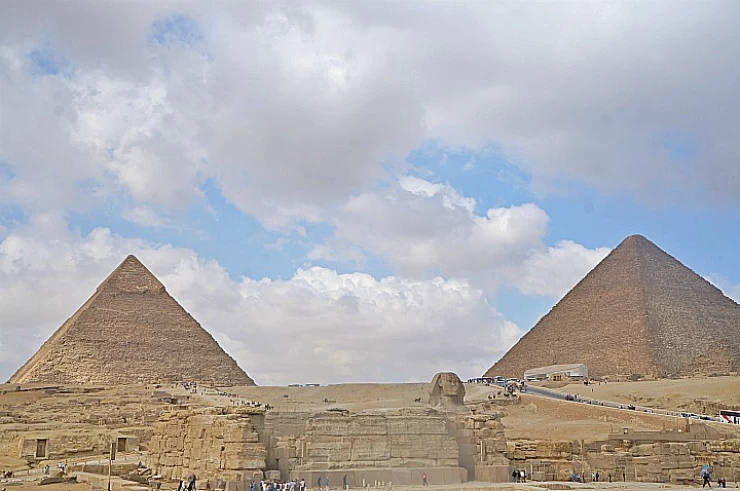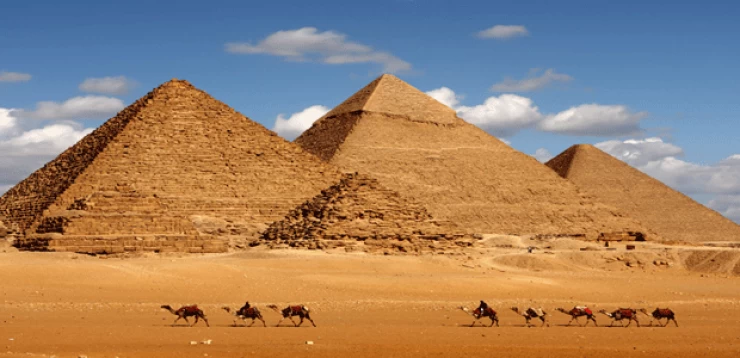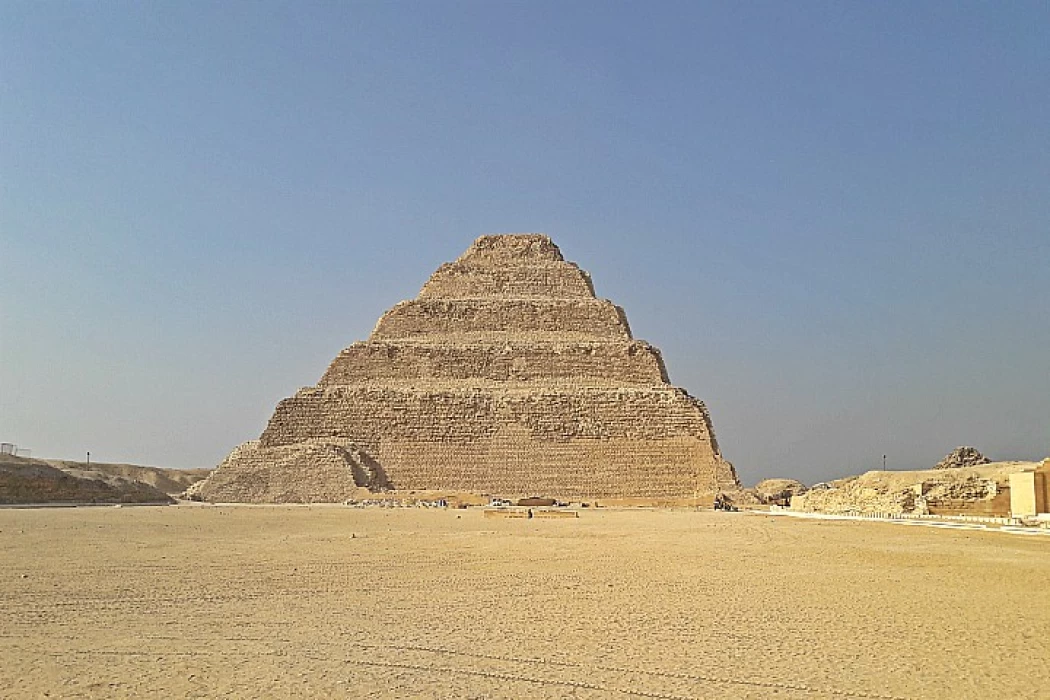
Saqqara Necropolis
Saqqara village is one of the villages belonging to the Badrashin Center in the Giza governorate of the Arab Republic of Egypt. At the 2006 census, Saqqara had a total population of 32,112, of whom 16,481 were men and 15,631 were women. Saqqara contains ancient Egyptian royal tombs of the dynasties that ruled Ancient Egypt from the capital menf. It also contains several pyramids, including the pyramid of Djoser, which dates back to the era of the Egyptian Third Dynasty, which is the oldest completed stone building known historically, in addition to several archaeological terraces
Sixteen other Egyptian kings built pyramids in Saqqara, in addition to some funerary monuments built by some high-ranking officials in ancient Egypt, and the area stretching from the pyramids of Giza to Dahshur passing through Saqqara was classified as a World Heritage Site by UNESCO in 1979.
History,
Djoser funeral complex
Tombs of APIs,
Since the time of the first and second Egyptian dynasties, some Egyptian nobles began to build their tombs in Saqqara. The first royal structures built in Saqqara were an archaeological terrace built during the reign of King Kha Sekhmoy, the last king of the second dynasty, which is now known as the Director's Bridge. Then the construction of archaeological terraces and pyramids in Saqqara followed during the reign of the following dynasties, among those monuments:
The buried pyramid, the funerary complex of King Sukhum-khat
The bridge of the director, the funeral complex of King Kha Sekhmoy
Pharaoh's Mastaba, the Tomb of King Shepseskaf (IV dynasty)
Pyramid of Userkaf (Fifth Dynasty)
The pyramid of the grandfather of Ka-Ra
The pyramid of King menkau Hor Kayu
Terrace t
The Mastaba of the brothers (Khnumhotep and nyankhnum)
Pyramid of Unas
Mostafa Ptahhotep
Pyramid of Teti (sixth dynasty)
Terrace of mariroka
Kajemni terrace
The wrong terrace
The pyramid of Pepi I
Meriner's pyramid
The pyramid complex of King Bibi II Nefer ka Ra
Burnup's grave (now in the Metropolitan Museum of Art in New York)
Pyramid of Ka - Ka-Ra-IBI (eighth dynasty)
Pyramid of the King, the dagger of Userkaf (XIII dynasty)
The tombs of Horemheb and Maya, some of whose inscriptions and statues are on display at the National Museum of Antiquities in Leiden, The Netherlands, and at the British Museum in London.
A monument to important thinkers and poets of ancient Greece has statues of Hesiod, Homer, Pindar, Plato, and others.
The archaeological area of Saqqara was robbed by looters during the 2011 Egyptian protests, where storage rooms were broken into, but most of the monuments were not damaged.
Recent discoveries,
During periodic excavations in 2011 in a cemetery for dogs in the cemetery of Saqqara, the excavation team led by Salima Ikram and an international team of researchers led by Paul Nicholson from Cardiff University discovered almost eight million animal mummies at the burial site next to the Holy Temple of Anubis. It is believed that those stuffed animals, mostly dogs, were intended to convey the prayer of their owners to their gods.
In July 2018, Ramadan Badri Hussein, head of the team of Egyptian-German researchers from the University of Tubingen, announced the discovery of an extremely rare gilded burial mask dating most likely from the Persian Safavid ERA in a partially damaged coffin. The last similar mask was found in 1939. The eyes of the mask are decorated with Obsidian, calcite, and a black gemstone, possibly Onyx. "Finding such a mask can cause quite a stir, as very few precious metal masks have survived to this day since most of the tombs of ancient Egyptian figures were looted in earlier eras," Hussein said.»
In September 2018, a team of Polish archaeologists led by Kamil Kuraskiewicz from the Faculty of Oriental Studies at the University of Warsaw found dozens of mummies dating back 2000 years. The Polish-Egyptian expedition was working under the auspices of the Polish Center for Mediterranean Archaeology at the University of Warsaw. The explorations in the area west of Djoser's pyramid lasted for more than two decades, and among those explorations was the Tomb of Minister Mirivnibeyev discovered in 1997, which contained a funeral chapel decorated with multi-colored carvings. In addition to the Tomb of the Courtier Nyan-khafr-Tim discovered in 2003. The expedition also explored two cemeteries. Archaeologists have discovered dozens of graves of nobles from the era of the Sixth Dynasty, dating from the period between the 24th and 21st centuries BC, as well as 500 graves of poor people dating from the period between the sixth century BC and the first century AD. Most of the bodies were in poor condition, all organic matter including wooden boxes had decomposed. These tombs, discovered in 2018, form part of the cemetery known as the Upper Cemetery. "The mummies that we discovered last season were very modest, they underwent only basic mummification operations, wrapped in bandages, laid directly in pits dug in the sand," says Kamil Kuraszkiewicz.»
The research of the Polish-Egyptian expedition also focused on the interpretation of the so-called dry moat, a vast trench dug around the pyramid of Djoser. The latest findings confirm the hypothesis that the dry moat was a model of the Pharaoh's journey to the underworld, a path that the deceased ruler had to follow to achieve eternal life.
In November 2018, An Egyptian archaeological expedition found seven ancient Egyptian tombs in the ancient cemetery of Saqqara containing a collection of scarabs and cat mummies dating back to the fifth and sixth dynasties. Three of them were used for cats, some of which date back more than 6,000 years, while one of the other four Noyes was previously unopened. Together with the cat mummies were 100 wooden statues of cats and one bronze statue dedicated to the cat goddess Bastet. In addition, funerary materials belonging to the twelfth Egyptian dynasty were found along with the skeletal remains of cats.
In mid-December 2018, the Egyptian government announced the discovery of a previously unknown 4,400-year-old tomb in Saqqara, containing paintings and more than fifty sculptures. This tomb belonged to the high-ranking priest Wahati, who lived during the reign of King Nefer-er-KARE Kakai, one of the Kings of the Fifth Dynasty. The cemetery also contained four pillars under which a sarcophagus was placed.
On April 13, 2019, an expedition led by a member of the Czech Institute of Egyptology, Mohammed Mujahid, discovered a 4,000-year-old tomb near the funerary city of Saqqara. Archaeologists have confirmed that the tomb belonged to an influential person named Khoy who lived in Egypt during the era of the Fifth Dynasty. "The L-shaped tomb of Khoy begins with a small corridor that leads down to a waiting room, and then a larger room with painted inscriptions depicting the owner of the Tomb sitting at the sacrificial table," says Mujahid."Some drawings preserved their splendor, and the tomb was mainly made of white limestone, with a tunnel entrance like the pyramids. Archaeologists suggest that there was a connection between Khoi and the king because the tomb is close to the pyramid of the Egyptian King GED Ka-ra, who ruled during that period.
On October 3, 2020, Khaled al-Anani, the Egyptian Minister of Tourism and Antiquities, discovered at least 59 closed stone sarcophagi containing mummies more than 2,600 years old. Archaeologists also discovered 20 statues of Ptah, a 35-centimeter bronze sculpture of the God nefertum.
On October 19, 2020, the Ministry of Tourism and Antiquities announced the discovery of a colorful and closed sarcophagus more than 2,500 years old. The archaeological team discovered gilded wooden statues and more than 80 sarcophagi. In November 2020, archaeologists discovered more than 100 finely painted wooden coffins and 40 funerary statues. These closed wooden coffins date back 2,500 years, and some of them contain mummies. Other artifacts discovered include funerary masks, urns, and amulets.
The archaeological area of Saqqara, part of the MANF cave, includes a large number of ancient Egyptian monuments, including the pyramid of King Djoser, the oldest monumental stone building in history from the Third Dynasty, the pyramids of several kings of the Fifth and sixth dynasties, the most important of which is the pyramid of King Unas the first to engrave his burial chamber with the texts of the pyramids, the Kings and senior officials of the first and second dynasties and a huge collection of tombs of senior individuals from the old state. It also included tombs dating back to the first transition era, passing through the tombs of members of the middle and modern states. The area also includes the burial of the sacred calf APIs (Serapeum), which continued to be used from the Eighteenth Dynasty until the Ptolemaic era. The area also includes Coptic monuments, including the monastery of Anba Jeremiah. The Imhotep Museum was opened in April 2006 in the region, to include a collection of artifacts discovered in Saqqara, and displays a model of the Djoser archaeological collection, in addition to the design of one of its halls in the form of a complete Tomb displaying a mummy, a wooden coffin and several pottery and alabaster vessels. the museum also includes the library of the French engineer Jean-Philippe Loire, who dedicated his life to the restoration of King Djoser's pyramid collection. this name was chosen for the museum after the minister of King Djoser and the architect who built his pyramid collection. The museum is currently closed for restoration.
To the southwest of Cairo and on the verge of the desert, there exists Saqqara, a design that can boast a lot about ancient Egyptian history, thus making it one of the archaeological sites. This vast expanse is known to be the extension of the burial grounds of Memphis City. Saqqara bears many interesting structures; some of them have managed to survive for more than 4700 years, containing tombs of the pharaohs, nobles, and even sacred pets. The most famous structure in the area is the Djoser Step Pyramid, claimed to be the first real pyramid and considered the largest stone-made structure of its kind within the range.
For this reason, this paper seeks to examine the historical significance of Saqqara, its major landmarks, and the beauty of this ancient city.
A Brief History of Saqqara
The historical importance of Saqqara can be traced back to the Third Dynasty of Egypt around 2650 BCE when Pharaoh Djoser ordered the construction of his pyramid complex. The Step Pyramid, designed by the legendary architect Imhotep, was a transformation in building techniques, giving way from the ordinary mud brick mastabas, which were flat-roof tombs, to decorated pine stone architecture. Over time, Saqqara developed into a large burial area that contained tombs from various dynasties and ages in ancient Egypt's history, which were the Old Kingdom, Middle Kingdom, New Kingdom, and even the later periods.
Like the rest of Memphis and its Necropolis, a UNESCO World Heritage Site, Saqqara is of great importance from the point of view of archaeology and history. Because of the many pyramids, mastabas, temples, and burial complexes present in the site, it also explain the evolution of the Egyptian way of burying their dead, the religious factors involved, and even the development of structures for several centuries.
the Step Pyramid of Djoser: An Architectural Marvel
The most important feature of Saqqara is undoubtedly the Step Pyramid of Djoser—the first ever constructed pyramid and a stunning illustration of Egyptian brilliance. The pyramid has a height of about 62 meters and consists of six steps of diminishing size so that the pyramid takes on its usual stepped shape. The architect of the chaste was the first to use stones in grand structures and set stone slabs that would later develop into the true pyramids of Giza.
Encircling the pyramid itself is a series of courtyards, temples, and other religious structures, most of which were designed to benefit the king in the next world. This includes the South Court, in which visitors may observe the ruins of several ancient shrines and altars used for ceremonial purposes. There is a huge compound wall with 14 gates encircling the complex, one of which was to be used for functional purposes, representing the final resting place of the king with no interference from the outside world.
Within the Step Pyramid structure, there exists a rat’s nest of stairways and rooms. Although the primary burial chamber was taken during antiquity, archaeologists have found astonishing amounts of items and valuables that help understand the culture and practices of the ancient Egyptians.
Saqqara’s Step Pyramid aside, the site is replete with numerous burial places of high-ranking officials, nobles, and members of the royal family. Decorated with finely carved images and wall paintings, the ancient Egyptian tombs illustrate aspects of life in ancient Egypt, including normal activities, religious practices, and iconography.
Tomb of Ti
The Tomb of Ti is one of the more recognized tombs in the Saqqara region. Ti was a high-ranking government official during the Fifth Dynasty. The tomb is famous for its intricate bas reliefs of daily activities in which Ti is shown active, such as tending to crops, going fishing, and making offerings to the deities. These images are not only beautiful but also very helpful in grasping the social, economic, and cultural aspects of the Old Kingdom.
The Mastaba of Mereruka
La Mastaba di Mereruka is another notable recognition within the Saqqara tombs. This is among the most considerable and richly decorated tombs of the necropolis. Mereruka was the visier and a son-in-law of Pharaoh Teti. His tomb contains an incredible number of rooms, a whopping thirty-two chambers, the walls of which are covered with relief images of the highest quality. The events depicted in these images give a detailed picture of many sectors of the ancient Egyptian civilization, ranging from medical practices and religious rites to leisure and domesticity.
The Serapeum: burial sites for the Apis Bulls.
The Serapeum from Saqqara is another interesting aspect that is a structure that was built primarily for burying sacred bulls referred to as the Apis, who took the guise of the god Ptah. The Serapeum consists of a series of underground corridors and galleries containing large stone coffins where the remains of the sacred bulls were interred. This complex is indicative of the Ancient Egyptians’ great love for animals and their unique beliefs about the divinization of certain animals.
New Discoveries at Saqqara: Uncovering Ancient Secrets
Saqqara remains an active site of archaeological research and exploration, and new finds help in addressing previously unknown portions of the ancient Egyptian civilization. Tombs, coffins, and a number of artifacts from different epochs ranging from the Old Kingdom to the Late Period have in recent years been excavated.
The tomb of Wahtye, a priest from the Fifth New Kingdom, monumental as it is, has a very well-preserved tomb bearing fine wall paintings illustrating the life and religious activities of the above-mentioned priest. Another important discovery presents a cache of sarcophagi and anthropoid wooden coffins, most of which are decorated; some were even closed and painted with varnish. These excavated materials help not only to understand the history of the Saqqara area more profoundly but also to reveal the importance of Saqqara as an archaeological site even in these days.
For those who would like to visit Saqqara, this place may be regarded as a temporal adventure as well as a treasure of some of the fantastic historical sites that one can find in Egypt. Allow us to share with you some useful information that would be helpful during your visit:
How To Get There: Saqqara is approximately 30 km from Cairo city center, which is southwest of Cairo, and can be reached by car quite comfortably. A number of tours include a visit to Saqqara, most of which visit other sites as well that are in the vicinity, such as the Giza pyramids and the Dahshur regions.
What to Put On: Since the location of Saqqara is situated in the desert, it's important to wear a suitable dress, and a cap, and protect the skin with sunscreen. Some good walking shoes are advisable since the ground in some places might be rugged.
Guided Tours: Even though it is feasible to visit Saqqara without the aid of a tour, the positive aspect is that a tour does help in improving the experience. Enriched guides help enrich the context and facts, making the ancient history and the importance of the site less than flat.
Other Sites of Interest: You can also make other site visits that are located within reach of Saqqara, for example, the Davis Pyramid, the Bent Pyramid, the Red Pyramid, and Memphis, all of which are located near Saqqara.
Conclusion: Saqqara’s Enduring Legacy
To say that Saqqara is important in ancient Egyptian history is a meager understatement. Its story is multilateral; it is the place where pyramid construction started and has been in use as a sacred burial site for more than three thousand years.
Saqqara comprises some of the most revolutionary structures, from the Step Pyramid of Djoser to the richly decorated niches of its temples, which reveal and preserve the creativity, religious beliefs, and longevity of ancient Egypt.
Saqqara is said to provide the best experience of the past along with the chance to tread like a pharaoh. Saqqara is such a mesmerizing place that almost every history buff and common person desirous of knowing about the ancient wonders of Egypt visits it without fail. It is still breathtaking, mysterious, and enchanting, full of timeless beauty.







